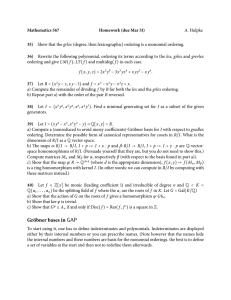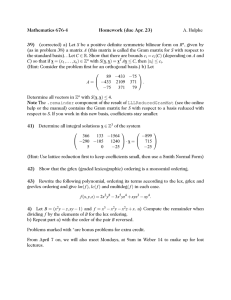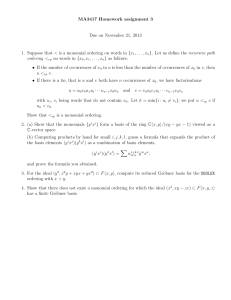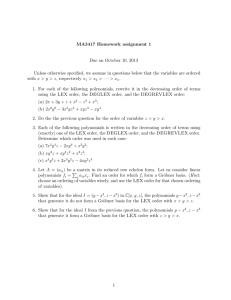Mathematics 467 Homework (due Mar. 6) 24) A. Hulpke
advertisement
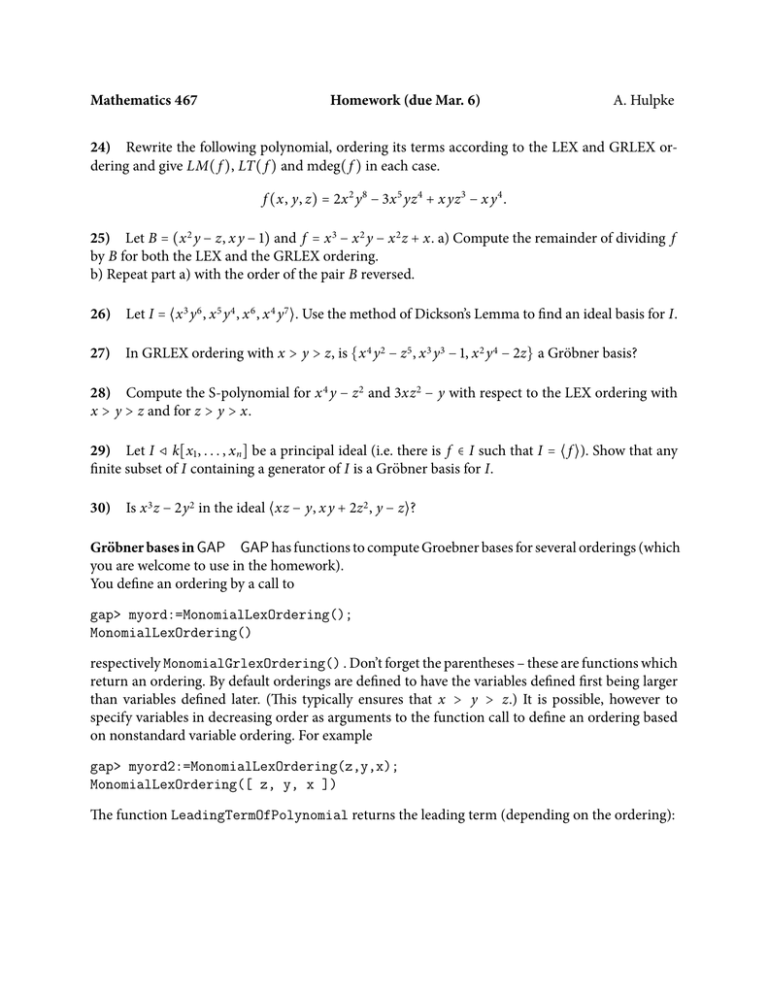
Mathematics 467
Homework (due Mar. 6)
A. Hulpke
24) Rewrite the following polynomial, ordering its terms according to the LEX and GRLEX ordering and give LM( f ), LT( f ) and mdeg( f ) in each case.
f (x, y, z) = 2x 2 y 8 − 3x 5 yz 4 + x yz 3 − x y 4 .
25) Let B = (x 2 y − z, x y − 1) and f = x 3 − x 2 y − x 2 z + x. a) Compute the remainder of dividing f
by B for both the LEX and the GRLEX ordering.
b) Repeat part a) with the order of the pair B reversed.
26) Let I = ⟨x 3 y 6 , x 5 y 4 , x 6 , x 4 y7 ⟩. Use the method of Dickson’s Lemma to find an ideal basis for I.
27) In GRLEX ordering with x > y > z, is {x 4 y 2 − z 5 , x 3 y 3 − 1, x 2 y4 − 2z} a Gröbner basis?
28) Compute the S-polynomial for x 4 y − z 2 and 3xz 2 − y with respect to the LEX ordering with
x > y > z and for z > y > x.
29) Let I ⊲ k[x1 , . . . , x n ] be a principal ideal (i.e. there is f ∈ I such that I = ⟨ f ⟩). Show that any
finite subset of I containing a generator of I is a Gröbner basis for I.
30)
Is x 3 z − 2y 2 in the ideal ⟨xz − y, x y + 2z 2 , y − z⟩?
Gröbner bases in GAP GAP has functions to compute Groebner bases for several orderings (which
you are welcome to use in the homework).
You define an ordering by a call to
gap> myord:=MonomialLexOrdering();
MonomialLexOrdering()
respectively MonomialGrlexOrdering() . Don’t forget the parentheses – these are functions which
return an ordering. By default orderings are defined to have the variables defined first being larger
than variables defined later. (This typically ensures that x > y > z.) It is possible, however to
specify variables in decreasing order as arguments to the function call to define an ordering based
on nonstandard variable ordering. For example
gap> myord2:=MonomialLexOrdering(z,y,x);
MonomialLexOrdering([ z, y, x ])
The function LeadingTermOfPolynomial returns the leading term (depending on the ordering):
gap> f:=2*x+3*y+4*z+5*x^2-6*z^2+7*y^3;
7*y^3+5*x^2-6*z^2+2*x+3*y+4*z
gap> LeadingTermOfPolynomial(f,myord);
5*x^2
gap> LeadingTermOfPolynomial(f,myord2);
-6*z^2
PolynomialReduction can be used to determine remainders. The first entry is the remainder, the
second the coefficients with respect to the list of basis elements. (Note that the division algorithm
works slightly different than the one in the book, thus if G is not a Gröbner basis you might get
different remainders.) PolynomialReducedRemainder returns the remainder only.
gap> B:=[x*y-y^2,y^2-x];
[ x*y-y^2, y^2-x ]
gap> PolynomialReduction(x^5*y,B,myord);
[ y^6, [ x^4+x^3*y+x^2*y^2+x*y^3+y^4, 0 ] ]
gap> PolynomialReducedRemainder(x^5*y,B,myord);
y^6
The commands GroebnerBasis and ReducedGroebnerBasis compute Gröbner bases for a given
generating set and ordering.
gap> GroebnerBasis(B,myord);
[ x*y-y^2, y^2-x, y^3-y^2 ]
gap> G:=ReducedGroebnerBasis(B,myord);
[ y^3-y^2, -y^2+x ]
By setting an appropriate InfoLevel higher, it is possible to get some information about the computation:
gap> SetInfoLevel(InfoGroebner,3);
gap> G:=ReducedGroebnerBasis(B,myord);
#I Spol(2,1)=y^3-y^2
#I reduces to y^3-y^2
#I |bas|=3, 4 pairs left
#I Spol(3,1)=y^4-x*y^2
#I Pair (3,2) avoided
#I Spol(3,3)=0
[ y^3-y^2, -y^2+x ]
